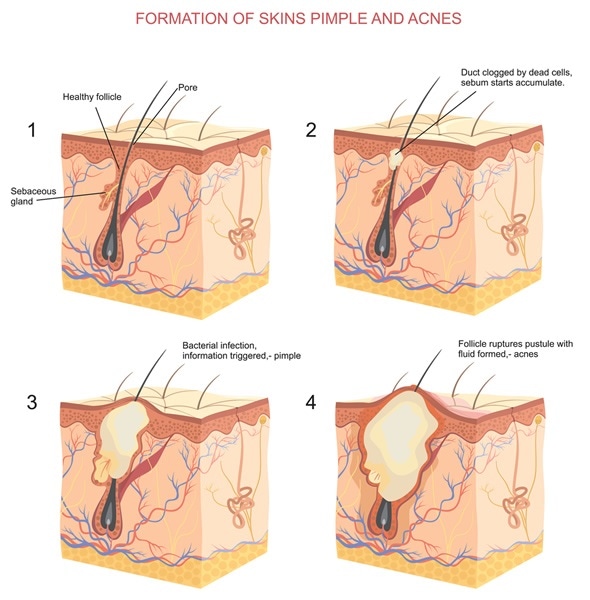
Blackheads and Whiteheads: Overview
Acne is a disorder of the pilosebaceous units in the skin. These are found most abundantly in the skin over the face, the upper chest, and the back. They are responsible for the growth of skin hair in addition to the lubrication of the skin.
The pilosebaceous units consist of a fine canal lined by keratinocytes, called the hair follicle, and an attached secretory gland called a sebaceous gland. The keratinocytes give rise to an outgrowth composed of keratin, a fibrous waterproof protein. This makes up a hair shaft, which emerges towards the skin by a tiny orifice, popularly called a skin pore.
The sebaceous gland produces a thick oily secretion called sebum which is secreted into the hair follicle. The sebum slowly reaches the skin surface along with dead cells from the keratinocyte layer, and other debris. If the canal of the hair follicle is plugged, a comedo results. This is the primary lesion of acne. It consists of a bump formed by accumulated sebum and the dead skin cells dilating a blocked follicle.

Formation of skins pimple and acnes - Image Copyright: logika600 / Shutterstock
Whiteheads
When the plugged follicle is closed off by a covering of skin, it appears white. This is called a whitehead and is capable of remaining in the skin for a long time. It may also become inflamed or evolve into another form. These are relatively firm and cannot be squeezed empty because the comedo is not in communication with the skin surface.
Blackheads
Blackheads are formed when the blocked follicle is open to the air. The sebum acquires a blackish color because of the oxidation of the fat by atmospheric oxygen, as well as from the dark pigment produced by the keratinocytes of the hair follicle. They look like black or yellowish spots and can be squeezed out, though this is not advised for fear of scarring. The black color is not due to dirt.
Acne Care
If a person has whiteheads or blackheads, skincare with regular face washes using mild soaps is important. Irritants such as dandruff and allergenic chemicals should not be used. If one has oily hair, washing hair daily or three times a week may be helpful. Non-comedogenic makeup is essential to prevent clogging of skin pores (follicle orifices).
Some people continue to have acne despite all these measures. In such a case, one may want to get a medical consultation if the problem is acute. Medications to treat acne may be topical or in the form of oral pills. It is also wise to keep from handling pimples, especially picking at them or bursting one which is filled with pus. This may not only result in scarring or discoloration of the skin, but could lead to the appearance of further pimples.
References
- https://www.womenshealth.gov/publications/our-publications/fact-sheet/acne.html
- https://newsinhealth.nih.gov/2010/January/feature2.htm
- https://girlshealth.gov/body/grooming/acne.html
- https://www.betterhealth.vic.gov.au/health/conditionsandtreatments/acne
- http://www.nhs.uk/Conditions/Acne/Pages/Introduction.aspx
Further Reading
Last Updated: Feb 26, 2019






















.png)










No hay comentarios:
Publicar un comentario